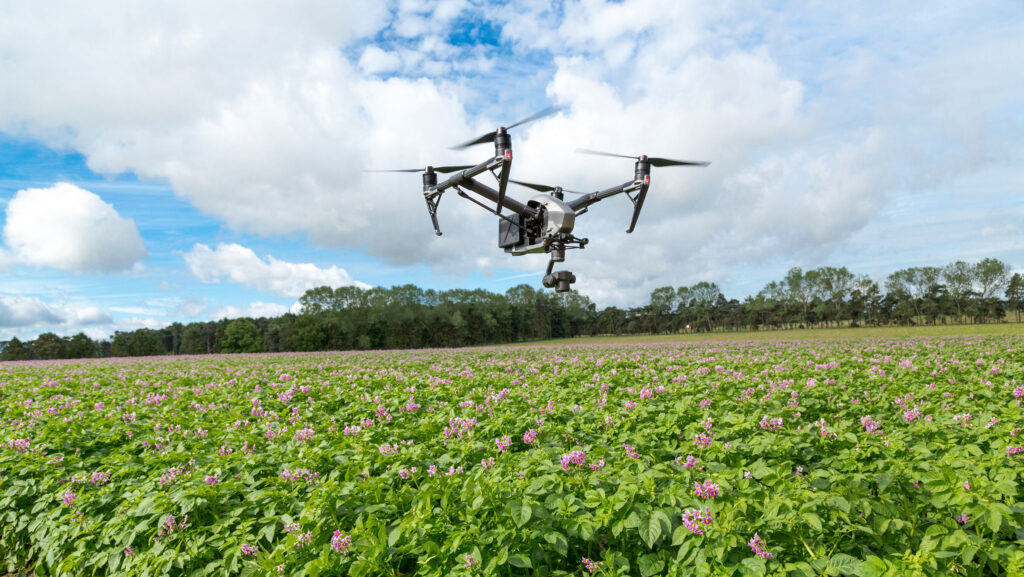How 3D crop mapping can future-proof potatoes
 © Gary Naylor Photography
© Gary Naylor Photography A world-leading potato research programme at Newcastle University is hoping to future-proof potatoes through a range of tools including 3D crop architecture mapping and early detection of pests and disease.
Dr Ankush Prashar, crop scientist and lecturer at the university, explains how the team are mapping the crop canopy of 300 potato varieties to gain a deeper understanding of how potato plants develop, as well as the variability in their architecture.
This will ultimately help them develop a more robust set of crop traits and enable the detection of diseases such as blight and nematode infestations before symptoms reveal themselves.
See also: Potato growing innovations to cut inputs and carbon footprint
Environmental factors
“We’re aiming to look at the genetic and physiological traits of different varieties and link this to how they adapt to different biotic and environmental stresses such as diseases, drought and sub-optimal nutrition,” he says.
“We then want to use this information to develop an evaluation toolkit for farmers. The aim is to work towards a ‘digital agronomist’ which incorporates and integrates different data streams.”
Part of the research is also using machine learning to distinguish between different potato varieties and develop a weed model that assesses which weed species are more likely to grow in certain soil types and with particular potato varieties.
“We want to investigate the importance of a range of parameters that affect potatoes simultaneously, including soil health, nutrition, weeds and disease.
“Previous modelling systems only consider one of these factors at a time, but we know in the field that these stresses are experienced together,” says Ankush.
3D canopy mapping
The research team are using low-cost drone imaging to create 3D surface models of the potato canopy, giving detailed data on plant height and canopy cover over the growing season.
This approach demonstrates how a better understanding of crop development can inform decision making and improve management practice.
“In terms of use for the farmer, canopy monitoring can identify key indicators of crop development and health.
“Early senescence or lodging, for example, could help predict the onset of disease. When combined with other datasets, this can help determine a variety’s optimal harvest date.”
Detection of late blight and nematodes in potato crops
Two PhD students at Newcastle University are investigating the early detection of blight in potato crops before symptoms are visible.
Blight lesions are normally seen in potato leaves about four days post-inoculation as the infected leaf cells begin to die.
However, technology can detect internal cellular response changes within the plant earlier in the pathogen’s infection cycle.
The research is based around two internal potato crop responses: structural and spectral.
“In healthy crops, crop cellular structures are strong and remain intact, ensuring optimal growth and function.
“When crops experience stress and become infected with disease, these structures begin to physically change – and this is what we are closely monitoring,” explains Newcastle University crop scientist Dr Ankush Prashar.
As infected cells die, leaves begin to yellow, affecting their light reflectance.
“Using high-tech cameras, signature wavelengths are being assessed to identify infected plants before cells begin to die,” says Ankush.
When this information is combined with in-field spore sensors, weather predictions and imaging sensors, farmers can access detailed forecasts.
The aim is to allow more targeted fungicide spraying, giving growers the confidence to reduce application frequency and perhaps increase rates during peak blight pressure to achieve more effective control.”
The PhD students are also using similar methods to monitor potato canopies.
Crops infected with nematodes can be identified without techniques that are destructive to the soil.
The Future of Food and Agriculture: Feeding the world sustainably

Farmers Weekly worked with the following partners to showcase the career opportunities in our dynamic, cutting-edge industry to more than 25,000 non-farming event visitors interested in science and technology.
Newcastle University took part in the Future of Food and Agriculture exhibit at New Scientist Live (12-14 October) in London.
Partners
Harper Adams University is our lead education partner


